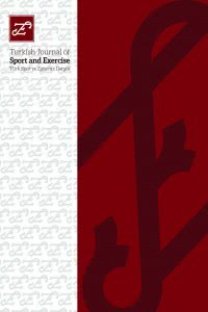Drop sıçramada optimal platform yüksekliğinin belirlenmesi
Determining optimal platform height in drop jump
___
- 1. Anonim (2007) Pliometrik Antrenman Metodunun Genç Atletlere Uygulanması Esnasında Dikkate Alınması Gereken Unsurlar. Erişim: http://www.odevsel.com.bilim/pliometrik...html. Erişim tarihi: 26.06.2011.
- 2. Asmussen E, Bonde-Peterson F. Storage of elastic energy in skeletal muscles in man. Acta Physiologica
- 3. Bobbert MF, Huijing PA, Van Ingen Schenau G J. Drop jumping I: The influence of jumping technique on the biomechanics of jumping. Medicine and Science in Sports and Exercise, 1987a; 19:332-338.
- 4. Bobbert MF, Huijing PA, Van Ingen Schenau G J. Drop jumping II: The influence of jumping technique on the biomechanics of jumping. Medicine and Science in Sports and Exercise, 1987b; 19:339-346.
- 5. Bobbert MF. Drop jumping as a training method for jumping ability. Sports Medicine, 1990; 9(1):7-22.
- 6. Bosco C, Vitasalo JT, Komi PV, Luhtanen P. Combined effect of elastic energy and myoelectrical potentiation during stretch-shortening cycle exercise. Acta Physiologica Scandinavica, 1982; 114(4):557-565.
- 7. Bosco C, Montanari G, Tarkkai I, Latteri F, Cozzi M, Iachelli G, et al. The effect of pre-stretch on mechanical efficiency of human skeletal muscle. Acta Physiologica Scandinavica, 1987; 131(3):323–329.
- 8. Brown ME, Mayhew JL, Boleach LW. Effect of plyometric training on vertical jump performance in high school basketball players. J. Sports Med. Phys. Fitness,1986; 26:1–4.
- 9. Chu, D.A. Jumping into Plyometrics. London : Prentice Hall Publishers. 1992: 3-29.
- 10. Clutch D, Wilton M, Mcgown C, Bryce GR. The effect of depth jumps and weight training on leg strength and vertical jump. Res. Q. Exerc. Sport, 1983; 54:5–10.
- 11. Ebben WP, Blackard DO. Strength and conditioning practices of National Football League strength and conditioning coaches. Journal of Strength and Conditioning Research,2001; 15:48–58.
- 12. Fatouros, IG, Jamurtas AZ, Leontsini, D, Taxildaris K, Aggelousis N, Kostopoulos N, Buckenmeyer P. Evaluation of plyometric exercise training, weight training, and their combination on vertical jumping performance and leg strength. Journal of Strength and Conditioning Research, 2000; 14(4):470–476.
- 13. Gulick, DT, Fagnani J, Long M, Morris K, Hartzell B. Parameters that influence vertical jump height. Sport Journal, 2008; 11(3):1.
- 14. Hewett TE, Stroupe A.L, Nance TA, Noyes FR. Plyometric training in female athletes. Decreased impact forces and increased hamstring torques. Am. J. Sports Med, 1996; 24(6):765-773.
- 15. Komi PV, Bosco C. Utilization of stored elastic energy in leg extensor muscles by men and women. Medicine and Science in Sports and Exercise, 1978; 10:261-265.
- 16. Kollias, I, Panoutsakopoulos V, Papaiakovoui G. Comparing jumping ability among athletes of various sports: Vertical drop jumping from 60 centimeters. Journal of Strength and Conditioning Research, 2004; 18(3):546–550
- 17. Lees A, Fahmi E. Optimal drop heights for plyometric training. Ergonomics, 1994; 37:141–148.
- 18. Makuruk H., Sacewicz T. The effect of drop height and body mass on drop jump intensity. Biology of Sport, 2011; 28:63-67.
- 19. Malisoux L, Francaux M, Nielens H, Theisen, D. Stretch-shortening cycle exercises: an effective training paradigm to enhance power output of human single muscle fibers. J. Appl Physiol, 2006; 100(3):771–779.
- 20. Markovic, G. Does plyometric training improve vertical jump height? A meta-analytical review. Biritish Journal of Sports Medicine, 2007; 41:349-355.
- 21. Markovic G, Jukic I, Milanovic D, Metikos, D. Effects of sprint and plyometric training on muscle function and athletic performance. Journal of Strength and Conditioning Research, 2007; 21(2):543–549.
- 22. Matavulj, D, Kukolj M, Ugarkovic D, Tihanyi J, Jaric S. Effects of plyometric training on jumping performance in junior basketball players. J. Sports Med. Phys. Fitness, 2001; 41(2):159–164.
- 23. Miller, B.P., Power, S.L.D. Developing power in Athletics through the process of depth jumping. Athletics Coach, 1981; 15(2):10-15.
- 24. Moynihan PS. Plyometrics: training and exercise. Track and Field Quarterly Review, 1983; 83:52-59.
- 25. Polhemus R. Plyometric training fort the improvement of Athletic Ability. Scholastic Coach, 1981; 51:68-69.
- 26. Song Chen-Yi, Peng HT, Kernozek TW, Wang YH. Biomechanical strategy during plyometric barrier jump-influence of drop-jump heights on joint stiffness. International Symposium on Biomechanics in Sports: Confeerence Proceedings Archive, 2010; 28(1).
- 27. Tınazcı, C. Çoklu Sıçrama Testinin Güvenirliliği ve Geçerliliği. Hacettepe Üniversitesi Sağlık Bilimleri Enstitüsü, Yüksek Lisans Tezi, Ankara. 1996.
- 28. Voigt M, Simonsen EB, Dyhre-Poulsen P, Klausen K. Mechanical and muscular factors influencing the performance in maximal vertical jumping after different prestretch loads. Journal of Biomechanics, 1995; 28:293–307.
- 29. Walsh M, Arampatzis A, Schade F, Brüggemann G. The effect of drop jump starting height and contact time on power, work performed, and moment of force. Journal of Strength and Conditioning Research, 2004; 18(3):561-566.
- 30. Young WB, Pryor JF, Wılson GJ. Effect of instructions on characteristics of countermovement and drop jump performance. J. Strength Cond. Res, 1995; 9:232–236.
- 31. Young WB, Wilson GJ, Byrne C. A comparison of drop jump training methods: effects on leg extensor strength qualities and jumping performance. Int. J. Sports Med,1999; 20:295-303.
- 32. Yu B, Hay JG. Angular momentum and performance in the triple jump: A cross sectional analysis. J. Appl. Biomech, 1995; 11:81–102.
- ISSN: 1300-9915
- Yayın Aralığı: Yıllık
- Başlangıç: 2018
- Yayıncı: -
Hakan Salim ÇAĞLAYAN, Mehmet Çağrı ÇETİN, YUNUS YILDIRIM, Özer YILDIZ
New technologies for motor didactics
Nadia CARLOMAGNO, Stefano TORE DI, Rosa SGAMBELLURİ, Veronica FRAGNITO, Filippo PALOMA GOMEZ
SÜLEYMAN CAN, AHMET ŞADAN ÖKMEN, ERDİL DURUKAN
Performance analysis and its didactic applicability in the motor-sports and educational field
Stefania CARROZZA, Giuseppe BALDASSARRE, Rodolfo VASTOLA, Filipo PALOMA GOMEZ
Basketbolcuların oyun pozisyonlarına göre reaksiyon zamanlarının karşılaştırılması
Düzenli egzersize katılımın egzersiz bağımlılığı üzerine etkisi
ÖZHAN BAVLI, M. Erkan KOZANOĞLU, AHMET DOĞANAY
Antinea AMBRETTI, Filippo PALOMA GOMEZ, Nadia CARLOMAGNO, Raffaele PROSPERİ, Maurizio SIBILIO
Yağlı güreşlere yönelik tutum ölçeğinin geliştirilmesi
Relative strength, body mass and height as predictors of olympic weightlifting payers performance
